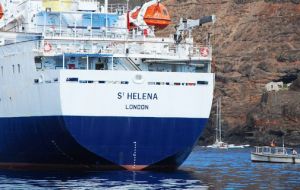MercoPress. South Atlantic News Agency
On St Helena Day, 21 May 2016, begins air link of the island with South Africa
 According to St Helena's Exco “the current RMS St Helena Shipping Schedule comes to an end in April 2016, just under 12 months away”.
According to St Helena's Exco “the current RMS St Helena Shipping Schedule comes to an end in April 2016, just under 12 months away”.  RMS St Helena will be anchored in Jamestown on the proposed official opening of the Airport on 21 May 2016, before a final voyage to the UK up the Thames
RMS St Helena will be anchored in Jamestown on the proposed official opening of the Airport on 21 May 2016, before a final voyage to the UK up the Thames  St Helena has been a prized possession of the British: in 1815, Napoleon was banished to the island until his death in 1821.
St Helena has been a prized possession of the British: in 1815, Napoleon was banished to the island until his death in 1821. British Overseas Territory St Helena only link with the outside world, currently by sea, will be coming to an end in May 2016, when the proposed official opening of the airport which is being built by South African contractors, will be taking place, according to the 12 May meeting of the island's Executive Council.
The current link of the volcanic island in the middle of the Atlantic with South Africa is done with RMS St Helena, a five-day trip to Cape Town, and the proposed date for the official opening of the airport is May 21, which also happens to be St Helena National Day. The weekly flight will be to Johannesburg.
According to Exco “the current RMS St Helena Shipping Schedule comes to an end in April 2016, just under 12 months away”. Likewise in its latest meeting ”approved the RMS Shipping Schedule from April 2016 to July 2016 and noted the proposed booking policy for the final voyages (241-243) of the RMS St Helena”.
The new schedule includes the following four key components: a final voyage to Tristan da Cunha in April 2016; RMS being anchored in Jamestown on the proposed official opening of the Airport on 21 May 2016; a final voyage to the UK and after disembarking her passengers RMS making a promotional trip up the river Thames and mooring alongside HMS Belfast near the Tower of London, and the RMS anchored in Jamestown for five days prior to its final sailing to Cape Town.
The focus of these final voyages is to commemorate the life of the RMS over the last 25 years and its strong links to the local community. Consequently, priority booking will be given to residents on St Helena, Ascension Island and Tristan da Cunha. In order to enable the maximum number of people to travel, group bookings will not be accepted (families will not count as a group) and St Helena Line will be looking to fill all available berths onboard.
Framed by craggy volcanic cliffs soaring 800 meters above sea level, the South Atlantic island measures just 122 square kilometers, smaller than central Paris. Uninhabited when it was discovered by the Portuguese in 1502, Saint Helena was founded under British rule in 1659.
It now has 4 200 inhabitants, about 850 living in the small capital of Jamestown, the only port, located on the island's northwestern coast.
Despite being close to the equator with latitude of 15 degrees South, St Helena has a varied climate, with a cactus-studded dry coast and humid interior lush with eucalyptus trees and Ireland-like pastures.
Its closest neighbor is Ascension Island, another British territory 1 200 kilometers to the northwest. Angola is nearly 2 000 kilometers to the east, the Brazilian coast 2 900 kilometers to the west. With its steep cliffs and rocky outcrops close to the shore, the island is particularly perilous.
Its isolation and hostile terrain - the fort-like cliffs make defending the island easy - have long made St Helena a prized possession of the British who have sent their most reviled and dangerous enemies to perish there.
In 1815, Napoleon was banished to the island until his death in 1821. After him, the Zulu chief Dinizulu ka Cetshwayo was sent there in 1890. A decade later, some 6 000 prisoners of the Boer war followed.
The colonial policy of island exile continued as recently as 1957, when three Bahraini princes opposing British policy in the Middle East were sent to St Helena.
St Helenians, or “Saints” as they are known, enjoy British nationality. The country elects an assembly of 12 members, five of who sit on local government, chaired by a governor sent from London.
Living mostly on British grants and expat income, St Helena imports almost everything it needs from Britain and South Africa. Its exports include fish, mostly tuna, and some coffee. Yet many hope the new airport will turn tourism into a major source of revenue.




Top Comments
Disclaimer & comment rules-

-

-

Read all comments“… .its isolation and hostile terrain - the fort-like cliffs make defending the island easy - have long made St Helena a prized possession of the British who have sent their most reviled and dangerous enemies to perish there.”
May 23rd, 2015 - 10:38 am 0Sounds like an excellent place to incarcerate KFC and Gollum!
How exciting is this...?
May 23rd, 2015 - 10:49 am 0I once looked at the possibility of visiting, but was put off by having to get a berth on a ship for days...
Probably a lot of folk have thought the same...it's a game changer...
This is the island where the English murdered Napoleão?
May 23rd, 2015 - 01:40 pm 0https://www.youtube.com/watch?v=t4-jcMwB2qI&list=FLmXPTu1f8AdGlizWNiASx2A&index=2
Commenting for this story is now closed.
If you have a Facebook account, become a fan and comment on our Facebook Page!